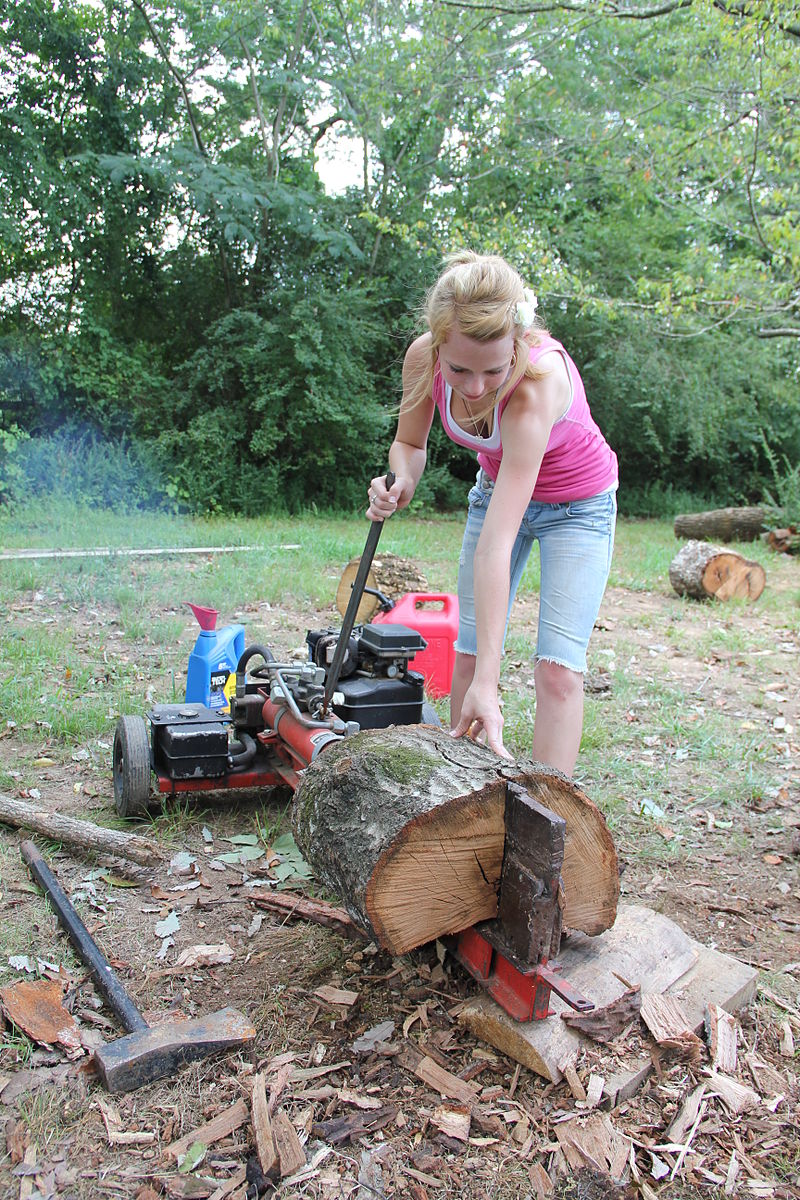Hey, it happens. We break stuff. Wait… are your log splitter parts breaking or getting damaged by your usage or your wrong equipment? Answer these questions first:
- Are you using a log splitter for commercial use or home use?
- Are you splitting mostly wet, unseasoned hardwoods?
- Are your rounds too large for your ram and blade?
- Is your log splitter the correct tonnage for the job?
“A log splitter is a piece of machinery or equipment used for splitting firewood from softwood or hardwood logs that have been pre-cut into sections (rounds), usually by chainsaw or on a saw bench. Most log splitter parts consist of a hydraulic or electrical rod and piston assembly and rated by the tons of force they can generate. The higher the pressure rating, the greater the thickness or length of the rounds are split.”

By Ks0stm – Own work, CC BY-SA 3.0, Link
Basic Parts of a Log Splitter
For most commercial or home-based splitters, it doesn’t matter much if you power the log splitter by an electric motor, a gas engine, or even a diesel engine. They all drive a hydraulic pump. And regardless of the power source and pump combination, a log splitter typically uses a hydraulic piston to drive the log through a fixed wedge or blade.
The Hydraulic Pump
Let’s start with the heart of the log splitter – the hydraulic pump. Did you notice I didn’t mention the engine or motor? Don’t get hung up on how big the engine or motor is. It is the primary mover, but it’s only good as the hydraulic pump it will operate.
Hydraulic pumps for log splitters usually are either a single-stage or a two-stage pump. Cheaper, often off-brand log splitters, and even some larger well-known commercial log splitters may come with a single-stage pump. A single stage pump will do the task, but it moves the hydraulic cylinder slower. Splitting time is increased. If you’re not concerned about time, then there’s no real concern about using this type of hydraulic pump.
Hydraulic two stage pumps are ideal for log splitters. A two-stage pump will first produce high volumes of low-pressure fluid (first stage). This stage moves the hydraulic cylinder in and out quickly. The two-stage model is great for moving the splitter ram up against the wood fast, and for retracting it fast.
When the pump encounters resistance (splitting wood), the second stage of operation engages. A calibrated valve will sense the pressure change and divert service to the pump’s high-pressure fluid stage for splitting. The volume of fluid (speed of the ram) will drop considerably during the second stage, but the force increases significantly. For example, a typical first-stage log splitter pump may unload fully around 450 psi while the second stage operates up to 3000 psi.
The Hydraulic Cylinder
The effectiveness of a log splitter ram determined by the bore size, the stroke length, and rod diameter. Bigger isn’t always better in this case. You have to have the correct amount of fluid volume and pressure matched to the cylinder for it to provide the proper force. For example: let’s say you placed a much more significant, higher volume ram in place of a smaller one. You may experience inadequate performance simply because your splitter isn’t able to handle the increased demand for fluid pressure and return.
Your return lines and fluid reservoir may be too small placing back pressure on the cylinder. The control valve porting may be too little doing the same. Your pump may not be able to deliver enough pressure due to a lack of fluid volume.
Since pressure creates heat, it’s recommended to use a reservoir that can hold a 3/1 ratio of fluid. Meaning, if your system uses one gallon of fluid each cycle, then your reservoir should hold three gallons. This gives the fluid time to cool down.
Log Splitter Parts Summary
It’s best to be sure you have matched components on your log splitter. Often a larger tonnage no-brand splitter may look very attractive at first, but the parts may be miss-matched, or of poor quality.
Determine your replacement log splitter parts needs by using calculators. Give Don’s Hydraulic Cheat Sheet a try. Just change the fields marked “Bore, Rod, Stroke, Pressure and GMP” to calculate your force and speed. To find a bore size, input the desired force you need and applied pressure to the ram. This will output the required bore size.
Whether you need a hydraulic filter or just cylinder repairs, Cylinder Services carries a quality range of log splitter parts including control valves, Prince Hydraulic Cylinders, NBC hydraulic log splitter pumps, and accessories. Be sure to check out our store.
